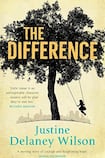
‘Take a photo of her wearing them! Before she takes them off. Go on, quick! Standing there, with them on, you’d never even know, would you, Steve?” A busybody neighbour buys Beth Rodgers’ toddler a pair of Hello Kitty sunglasses. Her crass comments refer to the fact that little Ismae has Down syndrome. In an affecting scene, Beth’s husband Steve walks out of the kitchen, appalled, leaving his wife to once more deal with the insensitivity of others in their insular suburban world.
The Difference, a story about a woman in her 40s whose late-born second child has Down syndrome, is at its sharpest when observing human behaviour. Family relations, marital problems, neighbourhood covens and the deep bond between a mother and her children are excavated by Justine Delaney Wilson in her debut novel. A freelance journalist who has worked in television research and production for over a decade, the Dublin author's non-fiction book The High Society was shortlisted at the Irish Book Awards in 2008 and caused controversy at the time for its details of Ireland's middle-class drug culture.
Delaney’s novel also focuses on a society, the closed-off world of Vesey Hill, a gated community in suburban Dublin where Beth and Steve live with their teenage son Al. The pregnancy is unexpected but welcome. Beth’s life is already stifled after relocating from London to her childhood town by the tyranny of group hairdressing appointments and coffee mornings in her neighbours’ houses, “Moirah and Anna ruling over the tractable cul-de-sacs”.
The author has a good ear for dialogue, particularly the awful things people say when faced with situations they haven't tried to understand. From her mother's persistent singling out of Ismae as different, to the cruelty of teenage boys telling big brother Al that if his sister was born in China, she'd have been killed, the way society reacts to people with Down syndrome is laid bare.
So too is Beth’s helplessness at the hand she’s been dealt. As her mother later notes over her own past misfortunes, “a maternity hospital is the cruellest place on earth to be when you have no baby to celebrate”.
The central characters in The Difference are well drawn and multidimensional. There is Beth's aloof mother, tethered to her own misery and only able to offer scraps of support to her daughter; her oafish, self-important husband who clearly loves his daughter and granddaughter, but loves himself and his extramarital pursuits more; the kindness of the immigrant neighbour Somner; the convincingly teenage voice of Al and his love for his sister. The star of the show is Ismae herself, whose too short scenes with Beth really bring the book to life.
We get to see Ismae being scrutinised by a clinical doctor in her first hours: “He didn’t offer any congratulations and I despised him, right then, in that room, with the passion of a hormonal 40-year-old.” At home some years later – the time shifts in the book are jarring – Ismae pieces together a jigsaw, mimics her mother in a curse word, and in a stirring moment, says her own version of “I love you” to Beth: “Her speech, when it came, was something soft and beautiful; her words without sharpness had soft edges, were furry almost.”
A major heart operation when Ismae is only three is equally well rendered through the use of the second person voice: “You will wake up with drains coming from your very insides, intubating tubes in your airways, pacing wires stuck to the surface of your heart.”
Ismae's struggle to have what healthy babies and their parents take for granted is the life blood of the novel, and makes for a moving story. But the book has many subplots and back stories that are inexpertly woven into the central narrative. From a prologue in an abortion clinic in the 1980s, to the troubled relationship of Beth's parents, to a new life in Steve's native New Zealand, there is a lack of cohesion between the threads. The disintegration of Beth and Steve's marriage is well handled at the start – "I wondered when we'd become so deadened. When we'd started undressing with our backs to each other" – but becomes cliched as it progresses.
Early and late chapters are much less interesting than the middle, which is unusual in a novel. There are random scenes and characters that add little – the wedding of an old college friend, an egregious ex-boyfriend, a barely referenced flatmate appearing at the end, a granny who pops up to give her two cents.
The suburban hell of Vesey Hill “and the gates that kept the rest of the world out” also needs more depiction. Scenes that show the reality of Beth’s present, both the difficulties and delights, are where the novel shines. It is through them that we come to understand that the concept of difference is the outside world’s view of something they can’t hope to grasp.
Sarah Gilmartin is an arts journalist













